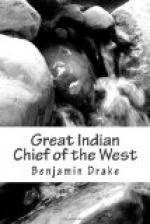CHAPTER VII.
General Atkinson overtakes Black Hawk—Battle of the Bad Axe—Atkinson’s official report—Incidents of the Battle—Capture of Black Hawk and the prophet—Naopope’s statement to General Scott—General Scott and Governor Reynolds conclude a treaty with the Sacs, Foxes and Winnebagoes—Causes which led to the war—Motives for getting up Indian wars—First attack made by the Illinois militia—Report of the Secretary at War in regard to this campaign—General Macomb’s letter to General Atkinson—Secretary Cass’ statement of the causes which led to this war—Comments upon this statement, and its omissions pointed out.
After the battle upon the Wisconsin, the whole army, under the command of General Atkinson, crossed to the north side of that river, at Helena, and on the twenty-ninth of July, commenced the pursuit of the Indians, by forced marches, over a rugged and mountainous country. On the morning of the second of August, while ten miles from the Mississippi, it was ascertained that the enemy were upon the bank of that stream, near the Bad-axe, and in the act of crossing to the west side. Arrangements were immediately made for an attack. Gen. Dodge’s squadron was placed in front, followed by the infantry, and these by the brigades of Henry, Alexander, and Posey. The army had proceeded in this order about five miles, when some Indians were discovered and fired upon. They immediately retreated to the main body, on the bank of the river. To prevent the possibility of the escape of the enemy, Generals Alexander and Posey, were directed to form the right wing of the army, and march to the river, above the Indian encampment, and then to move down along the bank. General Henry formed the left wing, and the United States’ infantry and General Dodge’s squadron, occupied the centre. In this order, the army descended a bluff bank into a river bottom, heavily timbered, and covered with weeds and brush-wood. General Henry first came upon a portion of the enemy, and commenced a heavy fire upon them, which was returned. General Dodge’s squadron and the United States’ troops, soon came into the action, and with General Henry’s men, rushed upon the Indians, killing all in the way, except a few who succeeded in swimming a slough of the Mississippi, about a hundred and fifty yards wide. During this time the brigades of Alexander and Posey, in marching down the bank of




